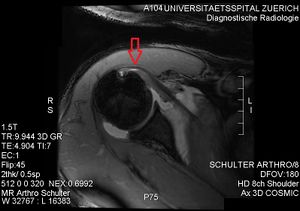Gerbers Test
Purpose[edit | edit source]
Gerber's test also known as Lift-Off Test (LOT) or Gerber's Lift-Off Test. It was first described by Gerber and Krushell(199l)[1]. It was developed to be used as a simple clinical manoeuvre, which can reliably diagnose or exclude clinically relevant rupture of the subscapularis tendon.
The Subscapularis is part of the 4 muscles, called the rotator cuff, which provide stability and strength to the shoulder joint during motion. The other 3 muscles include The Supraspinatus, The Infraspinatus, and The Teres Minor. Each of these muscles has its own special tests to check their integrity and functioning.
Another clinical test for the subscapularis was also described by Gerber et al in 1996, called the Belly Press Test (BPT) in response to patients who were unable to perform the LOT because of pain or limited joint range of motion
Technique[edit | edit source]
This test is performed in a standing position, with the examiner observing and testing from standing behind the patient.
To perform this test, the patient is asked to place the back of the affected arm (dorsum of the hand) in the mid lumbar spine area. The testing movement involves the patient performing internal rotation (IR), by lifting the hand off the back while the examiner places pressure on the hand[2].
The test is considered to be positive if the patient cannot resist, lift the hand off the back or if she/he compensates by extending the elbow and shoulder[2].
Limitations of this test involve the patient having full passive IR so that it is physically possible for the patient to place the arm in the desired position and pain is not a limiting factor during the manoeuvre.
Evidence[edit | edit source]
Greis et al[4] 1996 EMG analysis on " Validation of the Lift -Off Test and Analysis of Subscapularis Activity During Maximal Internal Rotation", determined the muscle activity of the shoulder muscles during the lift-off test and during resisted internal rotation. It demonstrated the activity in the upper and lower fibres of the subscapularis muscle during a lift-off test from the region of the mid-lumbar spine was approximately 70% of its maximum voluntary contraction, which was significantly higher than for all the other muscles tested (P < 0.05). The lift-off test resulted in one-third more electromyographic activity in the subscapularis muscle fibres than when the test was modified from the the hand being placed in the region of the mid-lumbar spine, to the hand at the buttocks region.
Resources[edit | edit source]
add any relevant resources here
https://pubmed.ncbi.nlm.nih.gov/21300808/
https://www.sciencedirect.com/science/article/pii/S1877056812002289
https://www.archives-pmr.org/action/showPdf?pii=S0003-9993%2811%2900795-7
References[edit | edit source]
- ↑ Gerber C and Krushell RJ. Isolated rupture of the tendon of the subscapularis muscle. Clinical features in 16 cases. The Journal of Bone and Joint Surgery. British volume 1991 73-B:3, 389-394
- ↑ 2.0 2.1 J. Barth, S. Audebert, B. Toussaint, C. Charousset, A. Godeneche, N. Graveleau, T. Joudet, Y. Lefebvre, L. Nove-Josserand, E. Petroff, N. Solignac, C. Scymanski, M. Pitermann, C.-E. Thelu. Diagnosis of subscapularis tendon tears: Are available diagnostic tests pertinent for a positive diagnosis?, Orthopaedics & Traumatology: Surgery & Research, 2012, Volume 98, Issue 8, Supplement, Pages S178-S185,
- ↑ Examination of the Rotator Cuff - Lift-off Test - Clinical Examination. Available from: http://www.youtube.com/watch?v=t9dSDVRbjn0
- ↑ 1. Greis PE, Kuhn JE, Schultheis J, Hintermeister R, Hawkins R. Validation of the Lift-Off Test and Analysis of Subscapularis Activity During Maximal Internal Rotation. The American Journal of Sports Medicine. 1996;24(5):589-593. doi:10.1177/036354659602400505
| The content on or accessible through Physiopedia is for informational purposes only. Physiopedia is not a substitute for professional advice or expert medical services from a qualified healthcare provider. Read more. |







